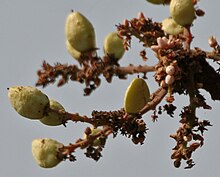Boswellia serrata: Difference between revisions
Content deleted Content added
→Research: primary research |
Just edited the name in saṃskṛtam Tag: Reverted |
||
| Line 8: | Line 8: | ||
}} |
}} |
||
'''''Boswellia serrata''''' is a plant that produces Indian [[frankincense]]. It is also known as Indian oli-banum, Salai guggul, and |
'''''Boswellia serrata''''' is a plant that produces Indian [[frankincense]]. It is also known as Indian oli-banum, Salai guggul, and sallakī (सल्लकी or शल्लकी) in Sanskrit.<ref>Pole, Sebastian (2013) Ayurvedic Medicine: The Principles of Traditional Practice. Singing Dragon Press. p.179</ref> The plant is native to much of [[India]] and the [[Punjab region]] that extends into [[Pakistan]].<ref>{{GRIN | accessdate=15 October 2014}}</ref> |
||
==Sustainability== |
==Sustainability== |
||
Revision as of 17:21, 4 July 2022
| Boswellia serrata | |
|---|---|

| |
| in Kinnerasani Wildlife Sanctuary, Telangana, India. | |
| Scientific classification | |
| Kingdom: | Plantae |
| Clade: | Tracheophytes |
| Clade: | Angiosperms |
| Clade: | Eudicots |
| Clade: | Rosids |
| Order: | Sapindales |
| Family: | Burseraceae |
| Genus: | Boswellia |
| Species: | B. serrata
|
| Binomial name | |
| Boswellia serrata | |
Boswellia serrata is a plant that produces Indian frankincense. It is also known as Indian oli-banum, Salai guggul, and sallakī (सल्लकी or शल्लकी) in Sanskrit.[1] The plant is native to much of India and the Punjab region that extends into Pakistan.[2]
Sustainability
Boswellia serrata is currently at risk of being eradicated because of non-sustainable practices.[3]
Research
Boswellia serrata contains various derivatives of boswellic acid including β-boswellic acid, acetyl-β-boswellic acid, 11-keto-β-boswellic acid and acetyl-11-keto-β-boswellic acid.[4]
Extracts of Boswellia serrata have been clinically studied for osteoarthritis and joint function, with the research showing trends of benefit (slight improvement) in pain and function.[5]
Gallery
-
Seeds
References
- ^ Pole, Sebastian (2013) Ayurvedic Medicine: The Principles of Traditional Practice. Singing Dragon Press. p.179
- ^ "Boswellia serrata". Germplasm Resources Information Network. Agricultural Research Service, United States Department of Agriculture. Retrieved 15 October 2014.
- ^ Bongers, Frans; Groenendijk, Peter; Bekele, Tesfaye; et al. (2019). "Frankincense in peril". Nature Sustainability. 2 (7): 602–610. doi:10.1038/s41893-019-0322-2. ISSN 2398-9629. S2CID 197402586.
- ^ Dragos, Dorin; Gilca, Marilena; Gaman, Laura; et al. (2017-01-16). "Phytomedicine in Joint Disorders". Nutrients. 9 (1): 70. doi:10.3390/nu9010070. ISSN 2072-6643. PMC 5295114. PMID 28275210.
- ^ Cameron, M; Chrubasik, S (22 May 2014). "Oral herbal therapies for treating osteoarthritis". The Cochrane Database of Systematic Reviews. 2016 (5): CD002947. doi:10.1002/14651858.CD002947.pub2. ISSN 1469-493X. PMC 4494689. PMID 24848732.





